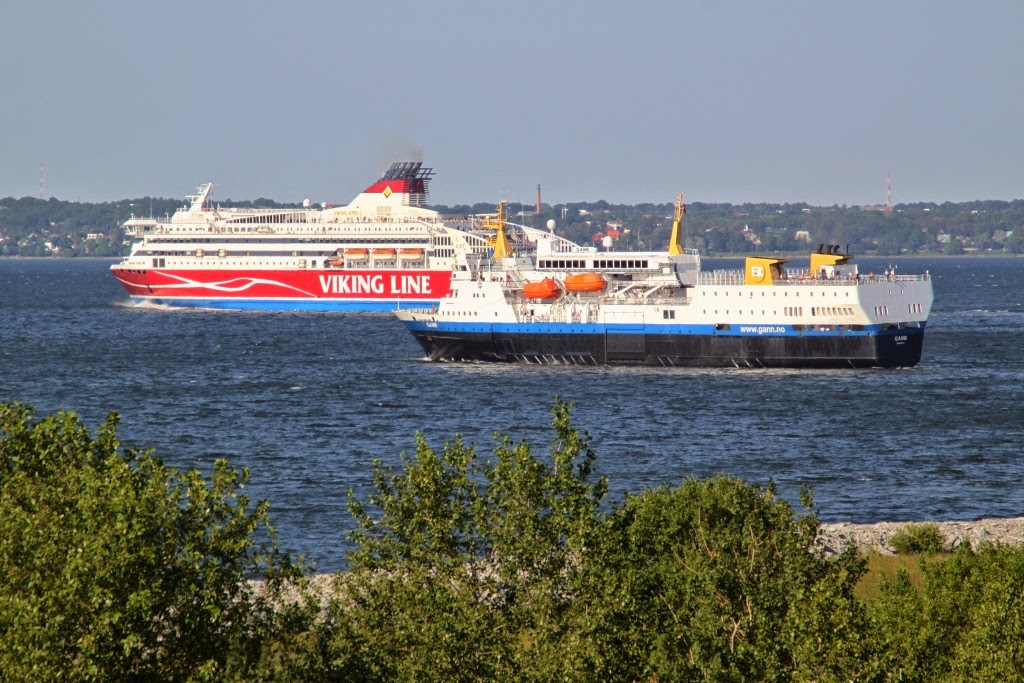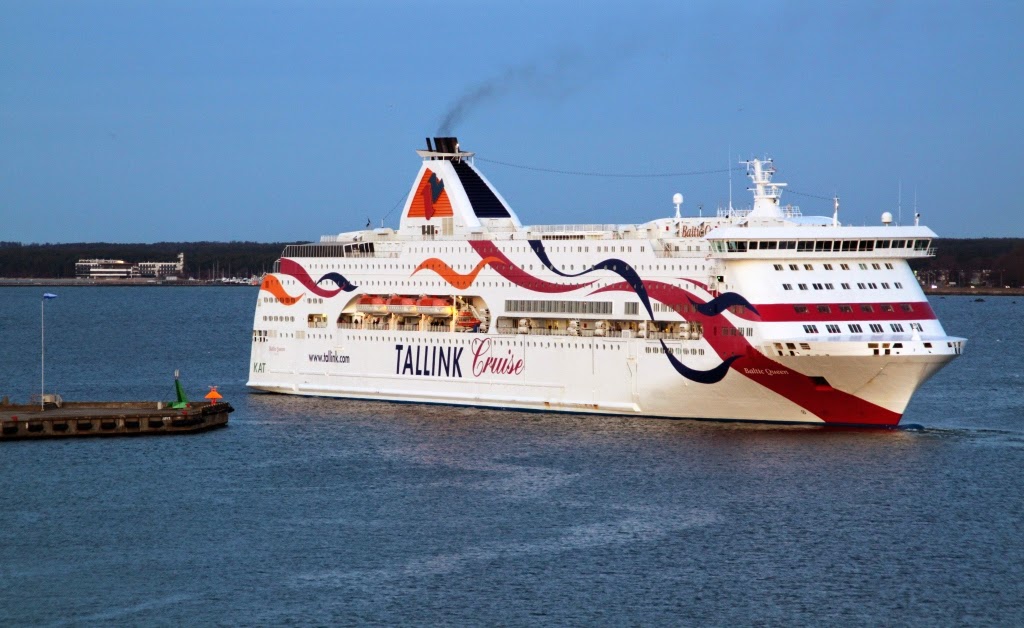During the past weekend, I had the chance to realise one of my long-time dreams: getting onboard a
Hurtigruten ship - albeit in this case a former Hurtigruten vessel, now used as a training ship: the
Gann (ex-
Narvik). Onboard photographs will be posted here in the coming days, and more verbose reportages from the visit will be published later in English at
MaritimeMatters and in Finnish on
Ulkomatala. But to start with, here are exterior shots of the Gann, as well as a short account of her history.
Gann
IMO 8019344
Name history:
Narvik, Gann
Built 1982, Trondhjems Mekaniske Verksted Trondheim, Norway
Tonnage 6 257 GT
Length 108,55 m
Width 16,50 m
Draught 4,74 m
380 passengers (in Norwegian internal traffic)
240 passengers (in international cruise service)
306 berths
2 Bergen diesels, combined 6 400 kW
2 propellers
2 bow thrusters
Service speed 15 knots
Maximum speed 17,5 knots
The
Narvik, as the ship was originally known, was the middle ship in Hurtigruten's three-ship-strong 1980s newbuilding programme (the so-called mid-generation ships); she was preceeded by the
Midnatsol and followed by the
Vesterålen. The planning process of this trio was somewhat complicated, as the companies operaring Hurtigruten and the Norwegian State - which paid for a lion's share of the construction costs - had very different ideas of what the next generation of coastal liners should be like. The Hurtigruten partners wanted ships with relatively large passenger capabilities, and wished to trust on roll-on/roll-off loading for cargo. The state, on the other hand, wanted lower passenger capacity and trusted in a lift-on/lift-off arrangement for cargo. The realised ships were thus compromises, with smaller passenger capabilities than their owners would have wanted, and equipped with both ro-ro car decks and a 22 TEU container deck.
The first ship, the
Midnatsol, was delivered November 1982 to Troms Fylkes Dampskibsselskab (TFDS), followed by just one month later by the
Narvik, delivered to Det Ofotens Dampsskibsselskab (ODS). The
Narvik differed for her elder sister somewhat in that she didn't have an observation lounge atop the ship like the
Midnatsol. Due to the lack of an observation lounge, the
Narvik's funnel was painted in the company funnel colours, whereas on the
Midnatsol the funnel was blank and the company colours were painted on the aft part of the observation lounge. The third sister, the
Vesterålen, was delivered in February 1983 to Vesteraalens Damskipsselskap (VDS). Structurally she was similar to the
Narvik, but unlike the other two sister, which had black and red hull colours, the
Vesterålen's hull was painted black and blue to better match the VDS funnel colours.
Almost immediately it became clear that the new trio of ships simply had too few cabins and too small passenger facilities. Initial attempts to fix the latter problem was to make the spaces more flexible by using movable walls and such, but in the end it was realised that the best thing to do was to give the sister radical refits. In 1989 the
Narvik sailed to the Motorenverke shipyard in Bremerhaven, West Germany, where her supecstructure was radically extended aftwards with cabins and a night club, eliminating the original container deck. At the same time she was fitted with an observation lounge atop the ship, similar but larger to the one onboard the
Midnatsol. Her sisters had undergone similar refits the year before. By this point, the
Narvik and
Vesterålen were owned by the same company, as in 1987 ODS and VDS had merged to form Ofotens og Vesteraalens Dambskibsselskap (OVDS).The new company adopted former ODS funnel colours and other markings, and such the change of ownership had no effect in the appearance of the
Narvik.
In April 1991 the
Narvik grounded on the Folla near Lysøsund. All apssengers were evacuated by the local ferry
Folla. The
Narvik suffered water damage to the cabins, corridors and cargo holds, as well as more serious damage to the port rudder, propeller and shaft gearings. Once refloated, the ship was repaired at Fiskerstrand Verft in Ålesund, returning to service at the end of May of the same year.
During the 1990s and the early 2000s the remaining Hurtigruten partners, OVDS and TFDS, radically modernised the coastal service fleet. By the time the two companies merged in early 2006, becoming Hurtigruten ASA, it was clear that the
Narvik's time with Hurtigruten was coming to a close. In December of that year and agreement was signed to sell the ship to Unge Sjømenns Kristne Forening (Young Seamen's Christian Association. For the purposes of this text I have chosen to abbreviate the name as USKF, though I have never seen such an abbreviation used myself), a privately owned Norwegian school for sailors, with delivery in April 2007.
On delivery to her new owners, the
Narvik was fiven the traditional USKF name
Gann. The current
Gann is the sixth ship, and the third ex-Hurtigruten ship, with that name. Following delivery she was given a new livery, with buff funnels with the USKF flag painted on them, and a blue stripe replacing the original red stripe on her hull (thus, interestingly, making her hull colours identical to the ones originally carried by her sister
Vesterålen). As the
Gann, the ship is primarily used as a training ship for aspiring seamen, but she also makes occasional cruises in order to raise funds for the school. In April 2010, during the period when European flight traffic was at a standstill following the eruption of the volcano Eyjafjallajökull in Iceland, the
Gann made two return trips from Stavanger to Newcastle, ferrying stranded tourists back home.
Obviously, the
Gann remains in USKF service today. Of her sisters, the
Vesterålen remains in Hurtigruten service, and looks set to remain there as no new ships are being planned by Hurtigruten (or at least there is no public knowledge of such plans), while the former
Midnatsol has been sailing since 2008 as the expedition ship
National Geographic Explorer.
The photographs below show the
Gann arriving at, in, and departing from the port of Tallinn on 6 July 2014. The photographs have been taken from onboard the
Silja Europa (the first five), from the cruise quay, and from Linnahall (the last two). As per the usual, click on the images to see them in larger size.
 |
| Photographing the Gann was a challenge due to her small size and the fact the areas with the best views are not accessible to the general public. Here the preserved harbour crane provides a neat way to "fill up" the image. |
 |
| The classic livery does look nice, even if the ship itself is of an unashamedly functional design. |
 |
| I could have done without the lamp-posts. |
 |
| Swinging around. The lighter spots on the aft superstructure are probably window reflections. |
 |
| Up close and personal. |
 |
| Several hours later, the Gann departed very close after the Viking XPRS, giving the chance for nice "sailing in tandem" photos. |
 |
| Of course, the high zoom makes the ships appear much close to each other than they really were. |



















































